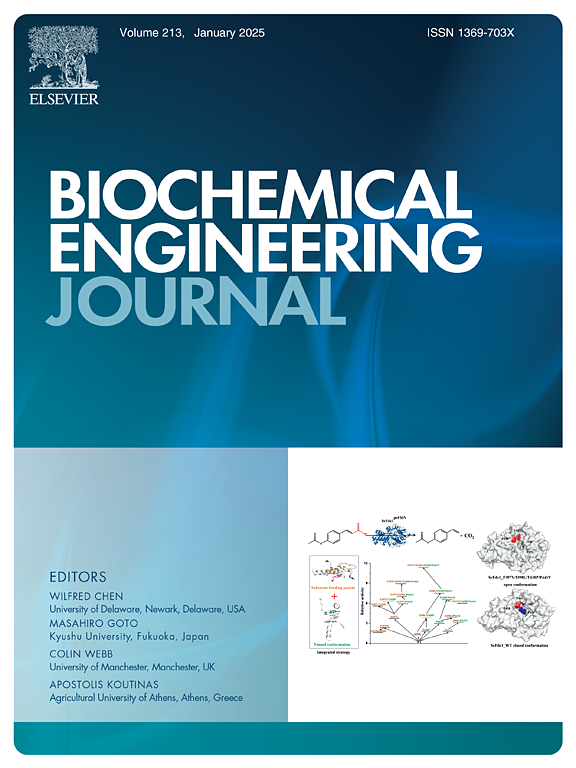Two-stage trophic strategy coupled with fed-batch operation for simultaneous enhancement of cell growth and lutein synthesis in Chlorella sorokiniana
IF 3.7
3区 生物学
Q2 BIOTECHNOLOGY & APPLIED MICROBIOLOGY
引用次数: 0
Abstract
The versatile trophic adaptability of Chlorella sorokiniana has garnered significant attention, establishing it as a promising alga for efficient lutein production. In this study, the lutein production characteristics of C. sorokiniana FZU60 were compared under autotrophic, mixotrophic, and heterotrophic conditions. The results demonstrated that glucose supplementation promoted algal cell growth but concurrently reduced lutein content. In contrast, light induction was essential for enhancing lutein synthesis. Consequently, two-stage trophic strategies were developed to simultaneously facilitate cell growth and lutein synthesis. It was determined that optimal lutein production could be achieved by employing the heterotrophy-mixotrophy strategy in conjunction with white light at 500 μmol/m2/s during the second stage (mixotrophic stage). Furthermore, combining the heterotrophy-mixotrophy strategy with fed-batch operation further enhanced the efficacy of lutein production in FZU60. The resulting lutein productivity demonstrated a remarkable 365.1 % improvement over the heterotrophy strategy (Strategy I) and an 80.8 % increase over the mixotrophy strategy (Strategy III), when both were coupled with fed-batch operation. These findings were subsequently validated in a 5 L fermenter where FZU60 exhibited exceptional lutein content, yield, and productivity reaching 6.14 mg/g, 285.02 mg/L, and 44.95 mg/L/d, respectively. Overall, this study successfully develops an effective cultivation strategy to address the inherent conflict between cell growth and lutein synthesis in algal cells, thereby demonstrating considerable potential as an industrial pathway for efficient lutein production.
两阶段营养策略结合补料分批操作同时促进小球藻细胞生长和叶黄素合成
小球藻(Chlorella sorokiniana)的多种营养适应性引起了人们的广泛关注,使其成为一种有希望高效生产叶黄素的藻类。在本研究中,比较了C. sorokiniana FZU60在自养、混合养和异养条件下的叶黄素生产特性。结果表明,葡萄糖的补充促进了藻类细胞的生长,但同时降低了叶黄素的含量。相反,光诱导是促进叶黄素合成的必要条件。因此,两阶段营养策略的发展,同时促进细胞生长和叶黄素合成。结果表明,在第二阶段(混合营养阶段)采用异养-混合营养结合500 μmol/m2/s白光可获得最佳叶黄素产量。此外,将异养-混合营养策略与补料分批操作相结合,进一步提高了FZU60叶黄素生产的效率。结果表明,与异养策略(策略I)相比,叶黄素产量提高了365.1 %,与混合策略(策略III)相比,当这两种策略都与进料批操作相结合时,叶黄素产量提高了80.8 %。这些发现随后在5 L的发酵罐中得到验证,FZU60的叶黄素含量、产量和生产力分别达到6.14 mg/g、285.02 mg/L和44.95 mg/L/d。总的来说,本研究成功地开发了一种有效的培养策略,解决了藻类细胞生长和叶黄素合成之间的内在冲突,从而显示出作为有效生产叶黄素的工业途径的巨大潜力。
本文章由计算机程序翻译,如有差异,请以英文原文为准。
求助全文
约1分钟内获得全文
求助全文
来源期刊

Biochemical Engineering Journal
工程技术-工程:化工
CiteScore
7.10
自引率
5.10%
发文量
380
审稿时长
34 days
期刊介绍:
The Biochemical Engineering Journal aims to promote progress in the crucial chemical engineering aspects of the development of biological processes associated with everything from raw materials preparation to product recovery relevant to industries as diverse as medical/healthcare, industrial biotechnology, and environmental biotechnology.
The Journal welcomes full length original research papers, short communications, and review papers* in the following research fields:
Biocatalysis (enzyme or microbial) and biotransformations, including immobilized biocatalyst preparation and kinetics
Biosensors and Biodevices including biofabrication and novel fuel cell development
Bioseparations including scale-up and protein refolding/renaturation
Environmental Bioengineering including bioconversion, bioremediation, and microbial fuel cells
Bioreactor Systems including characterization, optimization and scale-up
Bioresources and Biorefinery Engineering including biomass conversion, biofuels, bioenergy, and optimization
Industrial Biotechnology including specialty chemicals, platform chemicals and neutraceuticals
Biomaterials and Tissue Engineering including bioartificial organs, cell encapsulation, and controlled release
Cell Culture Engineering (plant, animal or insect cells) including viral vectors, monoclonal antibodies, recombinant proteins, vaccines, and secondary metabolites
Cell Therapies and Stem Cells including pluripotent, mesenchymal and hematopoietic stem cells; immunotherapies; tissue-specific differentiation; and cryopreservation
Metabolic Engineering, Systems and Synthetic Biology including OMICS, bioinformatics, in silico biology, and metabolic flux analysis
Protein Engineering including enzyme engineering and directed evolution.
 求助内容:
求助内容: 应助结果提醒方式:
应助结果提醒方式:


